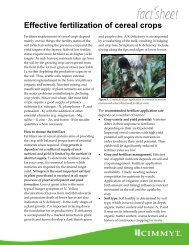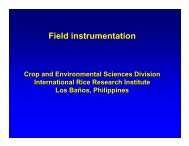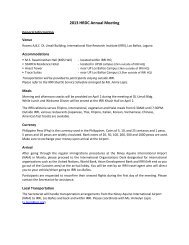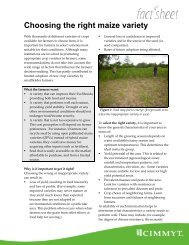Good water management practices - Rice Knowledge Bank ...
Good water management practices - Rice Knowledge Bank ...
Good water management practices - Rice Knowledge Bank ...
Create successful ePaper yourself
Turn your PDF publications into a flip-book with our unique Google optimized e-Paper software.
<strong>Good</strong> <strong>water</strong> <strong>management</strong> <strong>practices</strong>Worldwide, <strong>water</strong> for agriculture is getting increasingly scarce. By 2025, 15-20 million hectares ofirrigated rice may suffer <strong>water</strong> scarcity. Therefore, care must be taken to use <strong>water</strong> wisely and reduce<strong>water</strong> losses from rice fields. A few principles exist to “get the basics right” for good <strong>water</strong> <strong>management</strong>in paddy rice.Field channelsrice fact sheetsIn many paddy fields, <strong>water</strong> flows from one field to another through breaches in the bunds. Under suchconditions, <strong>water</strong> in an individual field can not be controlled and field-specific <strong>water</strong> <strong>management</strong> is notpossible - construction of channels to convey <strong>water</strong> to and from each field, or group of fields, greatlyimproves the irrigation and drainage of <strong>water</strong>.Land levelingA well-leveled field is aprerequisite for good <strong>water</strong><strong>management</strong>.When a field is not level, <strong>water</strong>may stagnate in the depressionswhereas higher parts may falldry.This results in uneven cropemergence, uneven earlygrowth, uneven fertilizerdistribution, and weedproblems. See the fact sheetson land leveling for more information.TillageEffect of uneven fields.Remedy: land leveling!Wet land preparation can consume up to a third of the total <strong>water</strong> used inpaddy rice. In large-scale irrigation systems, synchronizing operations andminimizing the duration of the land preparation period can reduce <strong>water</strong>use.Large amounts of <strong>water</strong> can belost during soaking prior topuddling when large and deepcracks are present. A shallowtillage to fill the cracks beforesoaking can greatly reducethis <strong>water</strong> loss.Land levelingShallow tillage to fill cracks beforeland soakingCracks cause large <strong>water</strong> lossesbefore soakingAfter soaking, thorough puddling results in a compactedplow sole that reduces <strong>water</strong> losses by percolation. Theefficacy of puddling depends on soil properties. Puddlingmay not be effective in coarse soils, whereas it is veryefficient in clay soils that form cracks during the fallowperiod. Puddling may not be necessary in heavy clay soilswith limited internal drainage. In such soils, direct dryseeding on land that is tilled in a dry state is possible withminimal percolation losses.Find Out More about Water Management in <strong>Rice</strong>:Send an email to: r.lampayan@cgiar.org.Visit http://www.knowledgebank.irri.orgDownload the book “Water <strong>management</strong> in irrigated rice - Coping with <strong>water</strong> scarcity”at: http://books.irri.org/9789712202193_content.pdfor at: http://www.irri.org/publications/techbulletin/tech.asp?id=10Developed with input from: B.A.M. Bouman and R. M. LampayanProduced by the International <strong>Rice</strong> Research Institute (IRRI) • © 2009, IRRI, All rights reserved • August 2009
<strong>Good</strong> <strong>water</strong> <strong>management</strong> <strong>practices</strong> – Page 2 of 2Bund<strong>Good</strong> bunds are a prerequisite to limit <strong>water</strong> losses by seepage and under-bund flows. Bundsshould be well compacted and any cracks or rat holes should be plastered with mud at thebeginning of the crop season. Also, check for, and repair new rat holes, cracks, and porositycaused by earth worms throughout the growing season. Plastic sheets can be used to repairespecially permeable parts of bunds.rice fact sheetsClose rat holesPonded <strong>water</strong> depth<strong>Good</strong> bunds avoid seepage lossesKeeping the depth of ponded <strong>water</strong> around 5 cm minimizes <strong>water</strong> losses by seepage andpercolation. See the fact sheet on Alternate Wetting and Drying for more information on field<strong>water</strong> <strong>management</strong>.Find Out More about Water Management in <strong>Rice</strong>:Send an email to: r.lampayan@cgiar.org.Visit http://www.knowledgebank.irri.orgDownload the book “Water <strong>management</strong> in irrigated rice - Coping with <strong>water</strong> scarcity”at: http://books.irri.org/9789712202193_content.pdfor at: http://www.irri.org/publications/techbulletin/tech.asp?id=10Developed with input from: B.A.M. Bouman and R. M. LampayanProduced by the International <strong>Rice</strong> Research Institute (IRRI) • © 2009, IRRI, All rights reserved • August 20092





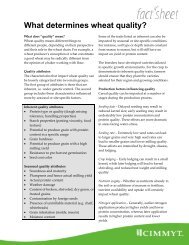


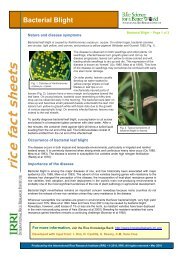
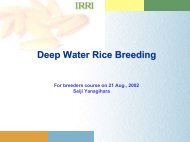
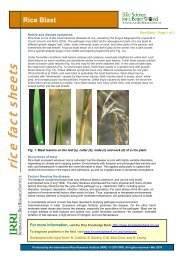
![International Standards' Organization â Rice Specification [ISO 7301]](https://img.yumpu.com/36696862/1/190x245/international-standards-organization-a-rice-specification-iso-7301.jpg?quality=85)

